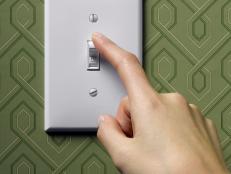Light Bulb Types

Thinkstock Images
The speed with which lighting technology is changing is particularly evident in the realm of the light bulb. Although Thomas Edison's incandescent light bulb had few competitors until fairly recently, the number of light bulb types grows daily, spurred by consumer demand for more energy efficient and durable lighting choices.
Another impetus: the L Prize, a U.S. Department of Energy competition, officially titled the "Bright Tomorrow Lighting Competition," which calls for energy efficient replacements to two of the most common light bulbs used in American homes today: the 60-watt incandescent and the PAR 38 halogen incandescent. The replacements must have similar color rendering and lumens characteristics but must be solid-state lighting products—light bulbs that use semiconductor light-emitting diodes (LEDs), organic light-emitting diodes (OLEDs), or polymer light-emitting diodes (PLEDs)—instead of electrical filaments.
Incandescent
Technically defined as a light bulb producing visible radiant energy by electrical resistance heating of a filament, this is the quintessential light bulb—the one Thomas Edison perfected in the 1880s and which has become the most pervasive light bulb in use. Factoid: The familiar light bulb is an A19, with the A referring to the overall shape and the 19 referring to the bulb being 19/8ths of an inch, or 2 3/8th inches, at its widest point.
Incandescents are prized for their warm color or CCT (typically 2,700-2,900 Kelvin), their color rendering or CRI (typically 90-100), and their familiarity—it is estimated that 75 percent of all light fixtures in American households use incandescent A19 light bulbs. Drawbacks of the incandescent include low efficacy (they are very inefficient), high heat generation and fragility.
The U.S. has set minimum efficiency standards that will take effect between 2012 and 2014, with the result that traditional incandescent light bulbs will begin to be phased out unless energy efficient versions are produced.
Halogen
Also known as tungsten halogen, this light bulb is an incandescent light bulb that contains a tungsten filament and a small amount of a halogen gas such as iodine or bromine. The halogen gas and tungsten filament produce a chemical reaction that aids in the longevity of the light bulb.
Halogen light bulbs are more energy efficient than traditional incandescents, have similar color rendering or CRI (typically 90-100), and a warm color or CCT (typically 3,000-3,200 Kelvin). A PAR 38 halogen is commonly used in recessed fixtures. PAR stands for parabolic aluminized reflector, meaning the light bulb has a hard glass bulb, an interior reflecting surface, a precisely placed filament, and a lens to control beam spread. 38 means the light bulb is 38/8ths of an inch, or 4 3/4th inches, in diameter at its widest point.
Small pin-pronged halogen bulbs used for reading lamps or undercabinet lighting are also familiar to consumers, but are less popular as they require delicate handling; the oil on human hands can shorten the light bulb's lifespan.
Fluorescent
Manufactured in both linear (tubes) or compact (A19, spiral or bent) shapes, a fluorescent light bulb contains mercury that is ionized by an electric arc, producing ultraviolet energy that causes phosphors coating the inside of the lamp to fluoresce or illuminate. Fluorescent light bulbs are prized for their energy efficiency, but are sometimes criticized for their poor color rendering or CRI (typically 60-80) and cool light color or CCT (typically 3,500-6,000 Kelvin).
However, new fluorescents are being produced with CRIs of 88, approaching incandescent, and warmer CCTs of 2,700 Kelvin. New electronic ballasts (versus older magnetic ballasts) have eliminated the flickering and buzzing that often occurred with linear fluorescent light bulbs; the ballast regulates current through the light bulb. Also, the size of the tubes has decreased, with slim T5 tubes, which measure 5/8ths of an inch, becoming a favorite for undercabinet lighting.
LED
An acronym for light-emitting diode, an LED light bulb has a semiconductor diode that radiates in the visible region of the spectrum. Many people associate LED lighting with the bright red or white display panels of digital clocks or appliances, but advancements in LED technology point to it becoming the light bulb of choice in the home. It is extremely energy efficient, and models may soon appear with color characteristics similar to incandescent; currently available LED light bulbs have color rendering or CRI ratings of 65-80 and warm CCT ratings of 2,700 Kelvin.
Xenon
Often used for undercabinet lighting, xenon light bulbs contain ionized xenon gas to produce light. Prized for their energy efficiency, xenon light bulbs may be used in place of small halogen light bulbs in undercabinet lighting and may be touched by hand without shortening its lifespan.
Changes to Efficiency Requirements
The U.S. Energy Independence and Security Act's (EISA) energy efficiency standards for incandescent light bulbs are slated to go into effect Jan. 1, 2012 (they are already in effect in California). Under these standards, traditional 100-watt incandescent light bulbs, which produce lumens in the 1,490-2,600 range, must use fewer than 72 watts to produce the same lumens. In 2013, the traditional 75-watt light bulb, with lumen range of 1,050-1,489, must use fewer than 53 watts. In 2014, the traditional 60-watt and 40-watt incandescent light bulbs, which produce 750-1,049 lumens and 310-749 lumens respectively, will be required to use fewer than 43 watts and 29 watts, respectively.




































